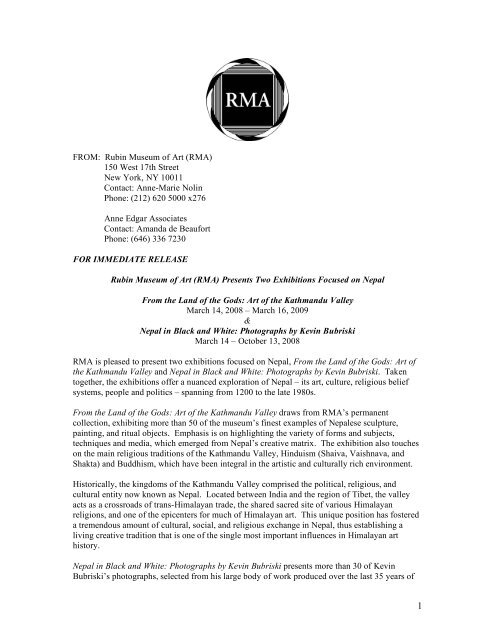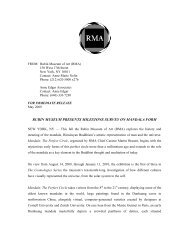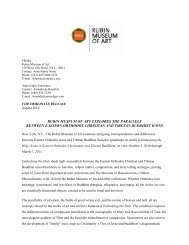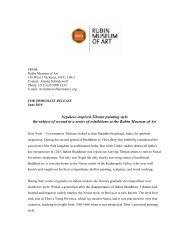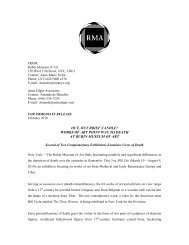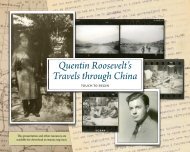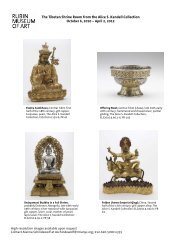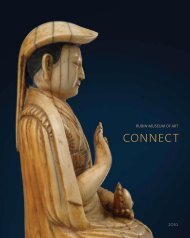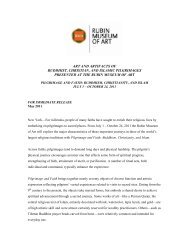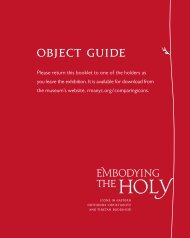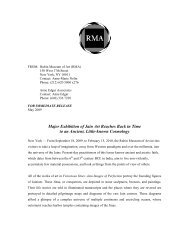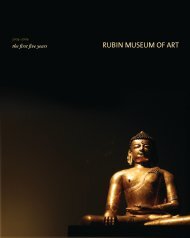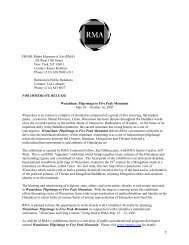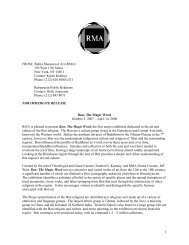Nepal in Black and White: Photographs by Kevin Bubriski
Nepal in Black and White: Photographs by Kevin Bubriski
Nepal in Black and White: Photographs by Kevin Bubriski
Create successful ePaper yourself
Turn your PDF publications into a flip-book with our unique Google optimized e-Paper software.
FROM: Rub<strong>in</strong> Museum of Art (RMA)150 West 17th StreetNew York, NY 10011Contact: Anne-Marie Nol<strong>in</strong>Phone: (212) 620 5000 x276Anne Edgar AssociatesContact: Am<strong>and</strong>a de BeaufortPhone: (646) 336 7230FOR IMMEDIATE RELEASERub<strong>in</strong> Museum of Art (RMA) Presents Two Exhibitions Focused on <strong>Nepal</strong>From the L<strong>and</strong> of the Gods: Art of the Kathm<strong>and</strong>u ValleyMarch 14, 2008 – March 16, 2009&<strong>Nepal</strong> <strong>in</strong> <strong>Black</strong> <strong>and</strong> <strong>White</strong>: <strong>Photographs</strong> <strong>by</strong> Kev<strong>in</strong> <strong>Bubriski</strong>March 14 – October 13, 2008RMA is pleased to present two exhibitions focused on <strong>Nepal</strong>, From the L<strong>and</strong> of the Gods: Art ofthe Kathm<strong>and</strong>u Valley <strong>and</strong> <strong>Nepal</strong> <strong>in</strong> <strong>Black</strong> <strong>and</strong> <strong>White</strong>: <strong>Photographs</strong> <strong>by</strong> Kev<strong>in</strong> <strong>Bubriski</strong>. Takentogether, the exhibitions offer a nuanced exploration of <strong>Nepal</strong> – its art, culture, religious beliefsystems, people <strong>and</strong> politics – spann<strong>in</strong>g from 1200 to the late 1980s.From the L<strong>and</strong> of the Gods: Art of the Kathm<strong>and</strong>u Valley draws from RMA’s permanentcollection, exhibit<strong>in</strong>g more than 50 of the museum’s f<strong>in</strong>est examples of <strong>Nepal</strong>ese sculpture,pa<strong>in</strong>t<strong>in</strong>g, <strong>and</strong> ritual objects. Emphasis is on highlight<strong>in</strong>g the variety of forms <strong>and</strong> subjects,techniques <strong>and</strong> media, which emerged from <strong>Nepal</strong>’s creative matrix. The exhibition also toucheson the ma<strong>in</strong> religious traditions of the Kathm<strong>and</strong>u Valley, H<strong>in</strong>duism (Shaiva, Vaishnava, <strong>and</strong>Shakta) <strong>and</strong> Buddhism, which have been <strong>in</strong>tegral <strong>in</strong> the artistic <strong>and</strong> culturally rich environment.Historically, the k<strong>in</strong>gdoms of the Kathm<strong>and</strong>u Valley comprised the political, religious, <strong>and</strong>cultural entity now known as <strong>Nepal</strong>. Located between India <strong>and</strong> the region of Tibet, the valleyacts as a crossroads of trans-Himalayan trade, the shared sacred site of various Himalayanreligions, <strong>and</strong> one of the epicenters for much of Himalayan art. This unique position has fostereda tremendous amount of cultural, social, <strong>and</strong> religious exchange <strong>in</strong> <strong>Nepal</strong>, thus establish<strong>in</strong>g aliv<strong>in</strong>g creative tradition that is one of the s<strong>in</strong>gle most important <strong>in</strong>fluences <strong>in</strong> Himalayan arthistory.<strong>Nepal</strong> <strong>in</strong> <strong>Black</strong> <strong>and</strong> <strong>White</strong>: <strong>Photographs</strong> <strong>by</strong> Kev<strong>in</strong> <strong>Bubriski</strong> presents more than 30 of Kev<strong>in</strong><strong>Bubriski</strong>’s photographs, selected from his large body of work produced over the last 35 years of1
his visits to <strong>Nepal</strong>, beg<strong>in</strong>n<strong>in</strong>g <strong>in</strong> 1975. The exhibition is composed of his black <strong>and</strong> whitephotographs, taken <strong>in</strong> the mid-1970s <strong>and</strong> mid-1980s. In addition, four of Kev<strong>in</strong> <strong>Bubriski</strong>’s colorphotographs will be on view <strong>in</strong> the lob<strong>by</strong> near RMA’s spiral staircase.Kev<strong>in</strong> <strong>Bubriski</strong>’s first <strong>in</strong>troduction to the country he would come to document over the years wasas a Peace Corps volunteer work<strong>in</strong>g on dr<strong>in</strong>k<strong>in</strong>g water supply pipel<strong>in</strong>es <strong>in</strong> remote mounta<strong>in</strong>villages. He carried a 35mm camera with him everywhere he went, tak<strong>in</strong>g photographs thatwould form the beg<strong>in</strong>n<strong>in</strong>g of the body of work he built up over the follow<strong>in</strong>g years. In 1984,Kev<strong>in</strong> <strong>Bubriski</strong> returned to <strong>Nepal</strong> as a photographer. This time, he carried with him a 4” x 5”view camera, a tripod, <strong>and</strong> the trapp<strong>in</strong>gs of a mobile professional set-up, travel<strong>in</strong>g the length <strong>and</strong>breadth of the country for the better part of three years.With unfl<strong>in</strong>ch<strong>in</strong>g clarity <strong>and</strong> sharp detail, the photographs <strong>in</strong> <strong>Nepal</strong> <strong>in</strong> <strong>Black</strong> <strong>and</strong> <strong>White</strong>:<strong>Photographs</strong> <strong>by</strong> Kev<strong>in</strong> <strong>Bubriski</strong> show the changes that took place between the mid-1970s <strong>and</strong>mid-1980s, especially the <strong>in</strong>fluence of Western society on a previously isolated culture.In his words:The realization that not only my camera but also the modern world was, <strong>in</strong> turn, mak<strong>in</strong>g ever<strong>in</strong>creas<strong>in</strong>g<strong>in</strong>trusions <strong>in</strong>to even the most remote areas of <strong>Nepal</strong> compelled me to document a time<strong>and</strong> way of life slipp<strong>in</strong>g <strong>in</strong>exorably <strong>in</strong>to the past.About RMARMA houses an esteemed collection of Himalayan art. The pa<strong>in</strong>t<strong>in</strong>gs, pictorial textiles, <strong>and</strong>sculpture are drawn from cultures that touch upon the 1,800 mile arc of mounta<strong>in</strong>s that extendsfrom Afghanistan <strong>in</strong> the northwest to Myanmar (Burma) <strong>in</strong> the southeast <strong>and</strong> <strong>in</strong>cludes Tibet,<strong>Nepal</strong>, Mongolia, <strong>and</strong> Bhutan. The larger Himalayan cultural sphere, determ<strong>in</strong>ed <strong>by</strong> significantcultural exchange over millennia, <strong>in</strong>cludes Iran, India, Ch<strong>in</strong>a, Central Asia, <strong>and</strong> Southeast Asia.The rich cultural legacy of this region, largely unfamiliar to Western viewers, offers anuncommon opportunity for visual adventure <strong>and</strong> aesthetic discovery. For young <strong>and</strong> old alike it isan environment <strong>in</strong> which to encounter the unknown <strong>and</strong> f<strong>in</strong>d mean<strong>in</strong>gful dialogue. It requiresactively br<strong>in</strong>g<strong>in</strong>g to bear one’s previous experience, look<strong>in</strong>g closely at the material at h<strong>and</strong>,discrim<strong>in</strong>at<strong>in</strong>g carefully, <strong>and</strong> shap<strong>in</strong>g the imag<strong>in</strong>ation. The fundamental aim of the museum is toprovide this adventure <strong>in</strong> learn<strong>in</strong>g through art.Work<strong>in</strong>g to foster connections between visitors <strong>and</strong> the art is RMA’s diverse team ofknowledgeable <strong>and</strong> professional guides who are always available on the gallery floors to answerquestions, engage <strong>in</strong> discussions, <strong>and</strong> help explore the art at any level. The guides work <strong>in</strong>concert with RMA’s ambitious schedule of exhibitions, education, <strong>and</strong> public programm<strong>in</strong>g,designed to provide multiple entryways to delve <strong>in</strong>to Himalayan art.2


